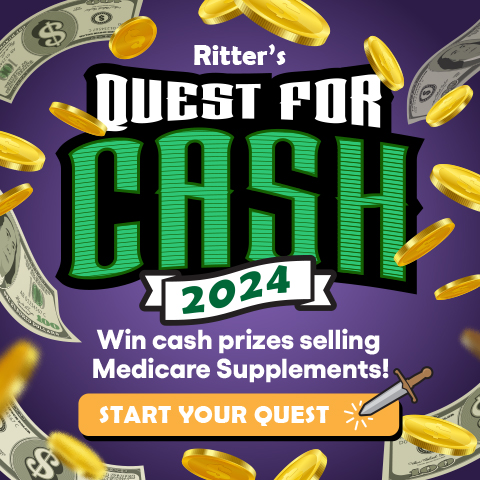You’ve made your pitch — now to see if it’s a hit or a miss. “So, would you like to sign up for this plan?” you ask. Your client’s eyes shift. “Um, no; not today,” they respond as they push their chair back. Maybe there was a better way to seal the deal, you think.
Closing the sale can be difficult, especially for beginner insurance agents. You want to come across as confident and knowledgeable but not pushy like a stereotypical car salesperson. Knowing how to utilize effective insurance sales closing techniques can help you strike the right balance and secure more clients and commissions.
Listen to this article:
Before we dive into specific sales techniques to close the deal, let’s talk about the foundation you need to build first.
Before You Try to Sell a Policy
Ever wonder why that stereotypical car salesperson gets a bad rap? It’s because they don’t have the time to build up a foundation of a relationship first. Of course, you want to sell insurance policies — that’s your job and way of making a living. But that job becomes a lot easier, more natural and meaningful, and fruitful if you form relationships with your clients before asking them to sign on the dotted line.
To effectively close a sale, your relationship must be built on three pillars: trust, interest, and identification of needs.
Trust
No one wants to buy something from someone they don’t trust. Here are some authentic ways to build trust in your relationship with your clients:
- Keep your facial expressions engaged and positive and your body language open
- Ask your clients questions about themselves (line of work, interests, family, pets, etc.)
- Echo back what they tell you to let them know you are listening
- Volunteer information about yourself in return (building trust goes two ways!)
- Provide educational information above and beyond the product you want to sell
- Give your clients ample amounts of your time and focus
- In subsequent conversations, ask follow-up/check-in questions about what they previously told you (e.g., how’d your grandson’s baseball game turn out?)
- Follow up with clients a month after enrollment, perform annual reviews, and provide extra value throughout your relationship (e.g., newsletter, classes on ancillary products, etc.)
Although building trust takes time, your client’s brain is wired to make a snap judgement about your trustworthiness. Set yourself up for long-term trust building by encouraging a positive first impression.
No one wants to buy something from someone they don’t trust.
Interest
This might seem obvious, but make sure your client is interested in what you’re presenting before you present it.
If you’re selling Medicare products and your client has filled out a Scope of Appointment (SOA) and scheduled an appointment with you, you can safely assume they’re interested in learning more about their Medicare options. But which options? That’s where a mini pitch can come in handy.
When first speaking with a lead, gauge their interest on Medicare Supplements (Med Supps), Medicare Advantage (MA), and Part D plans by giving brief descriptions and asking which products appeal to them the most. If they fill out an SOA, it should be easy to see what products they’re interested in learning more about and which they’re not.
If you’re selling other types of insurance products, be sure to go through their different product options and ask about their interest level in each. Your client will appreciate you taking the time to find out their interests and preferences, instead of bulldozing them with plan presentations they don’t want to hear.
Identify the Need
While you’re listening for your client’s interests and preferences, go deep on discovering what your client needs out of their insurance. Living on a fixed income? Perhaps the predictability of a Med Supp premium and lower out-of-pocket costs would be the best fit. What about a fixed income but they have a little emergency fund saved? Then, perhaps the lower premiums of an MA would be appealing.
Sometimes you have to go on a fact-finding mission to learn what your clients really need, especially if they are unsure of their options or not sure of what they need themselves. Introduce your fact-finding with something like, “I’d like to ask you some questions to determine what you need out of your health plan.” Then, ask questions about their financial situation, health conditions, providers, frequency of doctor’s visits, past hospital stays, prescription drugs, how often they travel out of state, etc. Listen closely to the answers and take notes!
It’s also a good idea to simply ask your client, “What do you think you need?” They’ll feel empowered to participate, and you’ll gather useful information.
Once you build trust and rapport, establish interest, and identify the need, you’re ready to move on to a product pitch.
Once you build trust and rapport, establish interest, and identify the need, you’re ready to move on to a product pitch. Establishing a strong foundation with your client before trying to sell them a specific plan will help you down the road, heading off objections your client might voice during an appointment.
Confidence Is Key
To be an effective insurance salesperson, you’ll want to foster a certain quality in yourself — confidence! Sit up straight, make eye contact and smile, and speak in a clear, measured voice. There’s a fine line between confidence and arrogance, though, and that’s why building the foundation described above is so essential.
Your confidence needs to be steeped in trust, relationship, and listening to your client. Without that, your confidence will come across as pushy. Remember, we’re trying to strike that fine balance between savvy advisor and aggressive salesperson.
4 Ways to Close the Deal
Once you’ve navigated the sales presentation, consider utilizing one of these techniques to close the sale.
1. The Assumptive Close
Let’s revisit the close used at the beginning of this article: “So, would you like to sign up for Carrier A’s plan?” Although it might seem considerate to phrase your request this way, it leaves the door wide open for your client to easily respond “No.” A simple, but effective, alternative is to adopt the assumptive close, assuming your client wants to continue rather than asking if they’d like to. This is a very powerful technique and pairs well or overlaps with other types of closes we’ll discuss below.
Although it might seem considerate to just ask your client if they’d like to sign up for a plan, it leaves the door wide open for your client to easily respond “No.”
Consider using some of these phrases for your assumptive close:
- “Thank you for helping me see that this plan will be a good fit for you. Let’s go ahead and get you signed up.”
- “I can walk you through the application now. Do you have your Original Medicare card handy?”
- “How would you like to enroll — by filling out this paper app or applying online? I’ll guide you through either!”
Read the room before trying an assumptive close. If your client is asking questions or saying things that lead you to believe they really aren’t interested in this product, avoid this type of close for now and find a different product that resonates. If you gauged their interest well, this shouldn’t be an issue. Blazing forward with an assumptive close when your client is giving you clear negative signals won’t help your trustworthiness.
2. The Modified Puppy Dog Close
A popular technique among car companies, the classic puppy dog close allows buyers to test out a product before committing to a full purchase. Think car test drives. The company Carvana employs the puppy dog close especially well, delivering the vehicle you’re interested in right to your door (or you pick it up) and giving you seven full days and up to 400 miles to decide whether you want to complete the purchase. Talk about a test drive!
What’s with the ‘puppy dog’ name? If you take an adorable puppy home over the weekend to “test it out,” it’s likely you’ll fall in love with it and want to keep it.
While insurance agents can’t offer “test drives” of products the same way car companies can, they can employ a modified version of this closing technique, which gives your client the promise of falling in love.
Try out some of these options:
- “Once you try this plan, you’re going to love it!”
- “I’m confident this plan is a good fit for you because of all the extra perks it provides. I’m sure you’re excited to test drive that prescription savings plan!”
But wait — stop the car! Your clients do get a test drive of certain Medicare products, namely MA plans. Don’t forget to explain and emphasize the option of the MA trial right to your clients. If you’re enrolling them in an MA plan during AEP, also don’t forget they could enroll in a different MA plan, or return to Original Medicare, during the MA Open Enrollment Period if they’re unhappy. Just make sure you’re following all the rules for the MA OEP!
3. The Alternate Choice Close
Who doesn’t like to have options? Popular among parents and salespeople alike, with an alternate choice close, you offer two or more choices, all of which end in a sale or outcome you like. This type of close overlaps with the assumptive close. (Can you spot our assumptive close example that provides the client with choices?) Be careful with the choice close and avoid belittling your client with meaningless options. No “Do you want to sign with a blue or black pen?” The goal is to actually empower your client to participate, not give the obvious illusion of choice.
The goal with an alternate choice close is to actually empower your client to participate, not give the obvious illusion of choice.
Try these instead:
- “I think this Medicare Supplement is going to be a good fit. Would it be easier for you to pay the premium as an annual chunk or by month?”
- “It sounds like you’re interested in both this MA and hospital indemnity plan. That’s great! Which application would you like to start with?”
- “I’m hearing that you like different pieces of this MA plan and Medicare Supplement. Do you think you would prefer a lower monthly premium with potentially higher out-of-pocket costs or a higher monthly premium with lower and more predictable out-of-pocket costs?” (After you get your answer, wrap up with an assumptive closing statement.)
As you can see, the alternate choice close could offer a range of little to big options. The second example is more about asking a client’s preference for something small (which application to start with). The third example takes more time to consider and is a bigger ask for your client. If you tend to favor the alternate choice close, especially within the same appointment, switch back and forth between the big and little choices so your client doesn’t get overwhelmed by a lot of bigger decisions.
4. The Summary Close
The summary close is another closing technique that pairs well with the assumptive close. In a summary close, you succinctly recap the benefits you’ve discussed and follow up with an assumptive closing statement (or you could ask for the sale if you’re confident your client will say yes). Your client will like the summary close because it demonstrates that you’ve listened to them, identified their needs, and searched for the best fit. Remember, before you jump into the benefits of the plan you’ve pitched, bring up some pain points your client feels. This will make the benefits seem all the more relevant.
Your client will like the summary close because it demonstrates that you’ve listened to them, identified their needs, and searched for the best fit.
For example:
- “I know your current MA plan caused you a big headache during your last cross-country trip. This Medicare Supplement is going to afford you so much more flexibility. You’ll be able to visit any doctor that accepts Medicare and have more predictable costs. We can get started on the underwriting process today! I’ll walk you through the process.”
- “Paying out of pocket for your eye exams and new glasses was certainly more expensive than you expected! The dental, vision, and hearing benefits of this MA plan are going to help with that so much. Let’s get the application started. It will only take about 10 minutes!”
- “You had sticker shock during your last hospital stay. This hospital indemnity plan is really going to help you out and bring those out-of-pocket costs way down! Do you have your personal information ready to get started on the application?”
See It in Action
Now that you’ve read about four effective closing techniques, watch them in action!
Remember, before you try to sell your client anything, build the foundation of a relationship first by establishing trust, gauging interest, and identifying needs. Then, with your increased confidence in these closing formulas, try out one (or more!) to seal the deal. Pretty soon, you’ll be a closing master! Not only will you have secured another sale and commission, but your client will trust that you have their best interests at heart and know what you’re talking about. That could mean referrals and increased business!
Still have questions? Our team of sales specialists here at Ritter know the power of an intentional sales approach. We want to help you hone your voice and unlock your full selling potential. Register with us for free to receive all our support, resources, and services that will help you get to “yes” more often.






Share Post